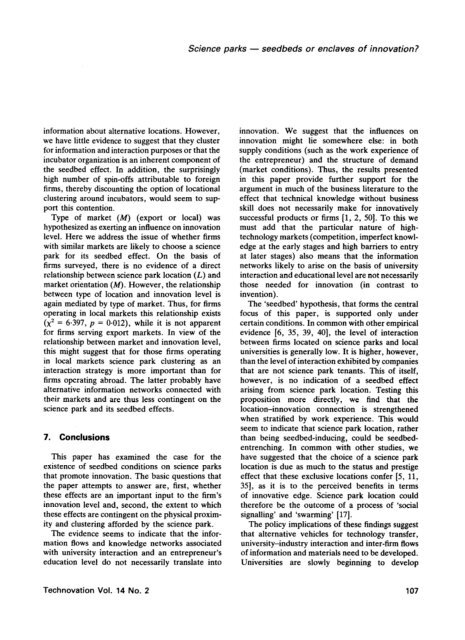University-related science parks - 'seedbeds' or 'enclaves' of ...
University-related science parks - 'seedbeds' or 'enclaves' of ...
University-related science parks - 'seedbeds' or 'enclaves' of ...
You also want an ePaper? Increase the reach of your titles
YUMPU automatically turns print PDFs into web optimized ePapers that Google loves.
Science <strong>parks</strong> - seedbeds <strong>or</strong> enclaves <strong>of</strong> innovation?inf<strong>or</strong>mation about alternative locations. However,we have little evidence to suggest that they clusterf<strong>or</strong> inf<strong>or</strong>mation and interaction purposes <strong>or</strong> that theincubat<strong>or</strong> <strong>or</strong>ganization is an inherent component <strong>of</strong>the seedbed effect. In addition, the surprisinglyhigh number <strong>of</strong> spin-<strong>of</strong>fs attributable to f<strong>or</strong>eignfirms, thereby discounting the option <strong>of</strong> locationalclustering around incubat<strong>or</strong>s, would seem to supp<strong>or</strong>tthis contention.Type <strong>of</strong> market (M) (exp<strong>or</strong>t <strong>or</strong> local) washypothesized as exerting an influence on innovationlevel. Here we address the issue <strong>of</strong> whether firmswith similar markets are likely to choose a <strong>science</strong>park f<strong>or</strong> its seedbed effect. On the basis <strong>of</strong>firms surveyed, there is no evidence <strong>of</strong> a directrelationship between <strong>science</strong> park location (L) andmarket <strong>or</strong>ientation (M). However, the relationshipbetween type <strong>of</strong> location and innovation level isagain mediated by type <strong>of</strong> market. Thus, f<strong>or</strong> firmsoperating in local markets this relationship exists(x2 = 6.397, p = O-012), while it is not apparentf<strong>or</strong> firms serving exp<strong>or</strong>t markets. In view <strong>of</strong> therelationship between market and innovation level,this might suggest that f<strong>or</strong> those firms operatingin local markets <strong>science</strong> park clustering as aninteraction strategy is m<strong>or</strong>e imp<strong>or</strong>tant than f<strong>or</strong>firms operating abroad. The latter probably havealternative inf<strong>or</strong>mation netw<strong>or</strong>ks connected withtheir markets and are thus less contingent on the<strong>science</strong> park and its seedbed effects.7. ConclusionsThis paper has examined the case f<strong>or</strong> theexistence <strong>of</strong> seedbed conditions on <strong>science</strong> <strong>parks</strong>that promote innovation. The basic questions thatthe paper attempts to answer are, first, whetherthese effects are an imp<strong>or</strong>tant input to the firm’sinnovation level and, second, the extent to whichthese effects are contingent on the physical proximityand clustering aff<strong>or</strong>ded by the <strong>science</strong> park.The evidence seems to indicate that the inf<strong>or</strong>mationflows and knowledge netw<strong>or</strong>ks associatedwith university interaction and an entrepreneur’seducation level do not necessarily translate intoinnovation. We suggest that the influences oninnovation might lie somewhere else: in bothsupply conditions (such as the w<strong>or</strong>k experience <strong>of</strong>the entrepreneur) and the structure <strong>of</strong> demand(market conditions). Thus, the results presentedin this paper provide further supp<strong>or</strong>t f<strong>or</strong> theargument in much <strong>of</strong> the business literature to theeffect that technical knowledge without businessskill does not necessarily make f<strong>or</strong> innovativelysuccessful products <strong>or</strong> firms [l, 2, 501. To this wemust add that the particular nature <strong>of</strong> hightechnologymarkets (competition, imperfect knowledgeat the early stages and high barriers to entryat later stages) also means that the inf<strong>or</strong>mationnetw<strong>or</strong>ks likely to arise on the basis <strong>of</strong> universityinteraction and educational level are not necessarilythose needed f<strong>or</strong> innovation (in contrast toinvention).The ‘seedbed’ hypothesis, that f<strong>or</strong>ms the centralfocus <strong>of</strong> this paper, is supp<strong>or</strong>ted only undercertain conditions. In common with other empiricalevidence [6, 35, 39, 401, the level <strong>of</strong> interactionbetween firms located on <strong>science</strong> <strong>parks</strong> and localuniversities is generally low. It is higher, however,than the level <strong>of</strong> interaction exhibited by companiesthat are not <strong>science</strong> park tenants. This <strong>of</strong> itself,however, is no indication <strong>of</strong> a seedbed effectarising from <strong>science</strong> park location. Testing thisproposition m<strong>or</strong>e directly, we find that thelocation-innovation connection is strengthenedwhen stratified by w<strong>or</strong>k experience. This wouldseem to indicate that <strong>science</strong> park location, ratherthan being seedbed-inducing, could be seedbedentrenching.In common with other studies, wehave suggested that the choice <strong>of</strong> a <strong>science</strong> parklocation is due as much to the status and prestigeeffect that these exclusive locations confer [5, 11,351, as it is to the perceived benefits in terms<strong>of</strong> innovative edge. Science park location couldtheref<strong>or</strong>e be the outcome <strong>of</strong> a process <strong>of</strong> ‘socialsignalling’ and ‘swarming’ [ 171.The policy implications <strong>of</strong> these findings suggestthat alternative vehicles f<strong>or</strong> technology transfer,university-industry interaction and inter-firm flows<strong>of</strong> inf<strong>or</strong>mation and materials need to be developed.Universities are slowly beginning to developTechnovation Vol. 14 No. 2 107
















